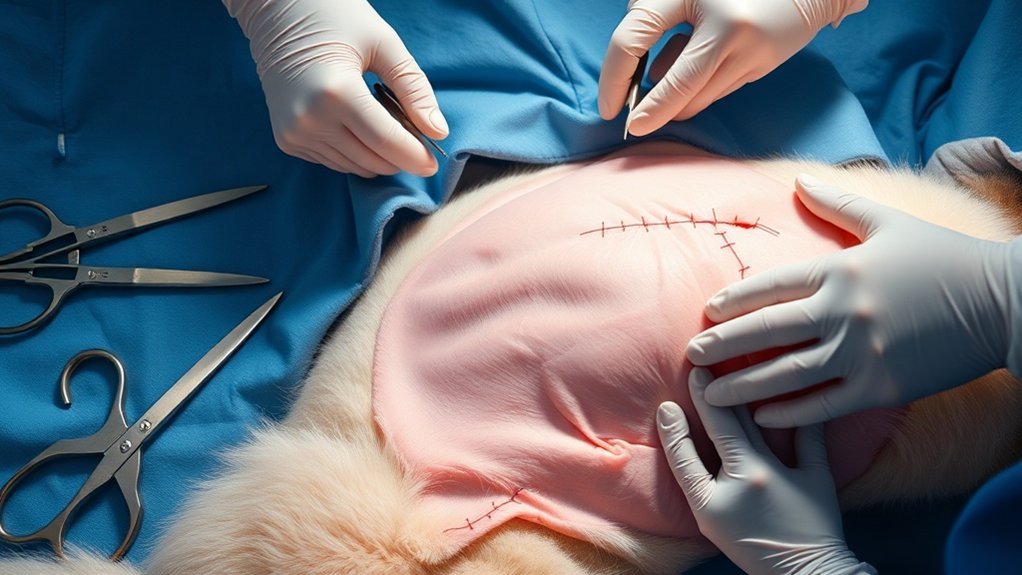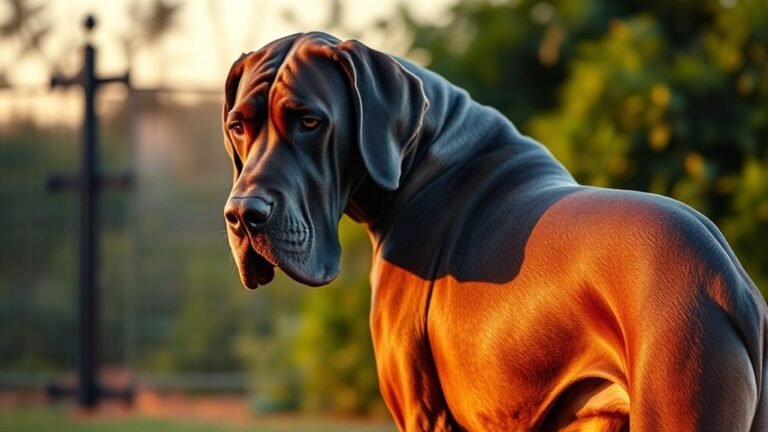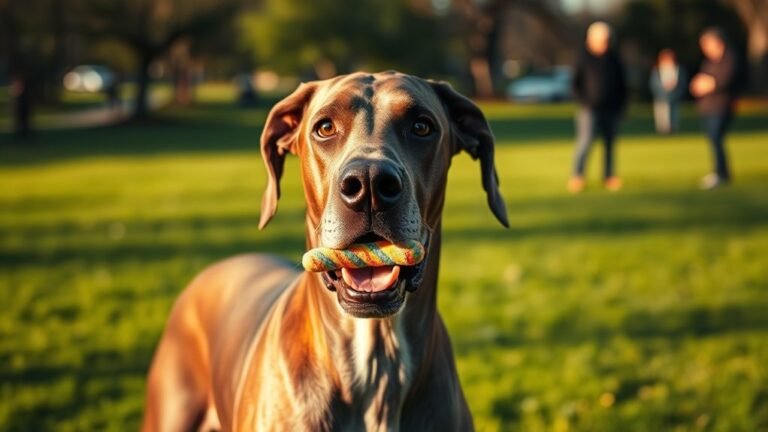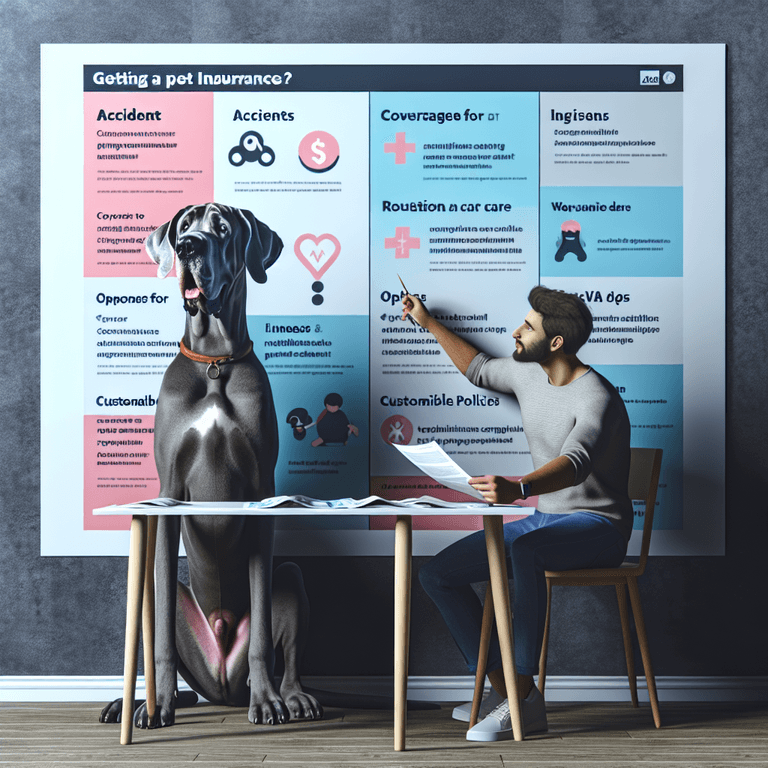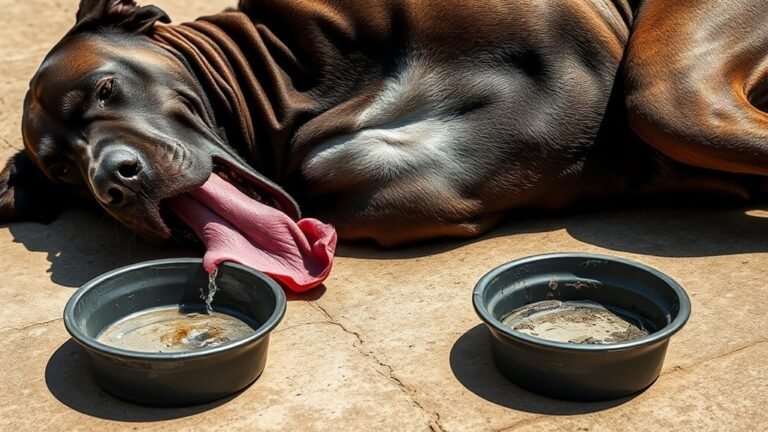No More Belly Flips—Thanks, Mom and Dad!
Great Dane Stomach Tacking
Woof! Let me tell you about something called stomach tacking that us Great Danes need to know about. It has a fancy name too – gastropexy – but I prefer calling it stomach tacking because that’s exactly what it is!
So here’s the deal. Us Great Danes have this problem where our stomachs can flip around inside our bellies. It’s called GDV or bloat, and trust me, it’s not fun at all. Almost half of us Great Danes will encounter this scary thing at some point in our lives. That’s way too many of my buddies!
The good news is that our humans have found a way to help us. They can do this surgery where they basically staple our stomach to our belly wall so it can’t flip around anymore. Pretty clever, right? It stops bloat from happening 95% of the time. Those are odds even I can understand!
The best part is they usually do this surgery when we’re already getting spayed or neutered. So we’re already taking a little nap for surgery anyway. It’s like getting two things done at once – very efficient!
After surgery, I have to take it easy for about two weeks. No crazy zoomies around the yard or wrestling with my dog friends. Just lots of napping and gentle walks. The hardest part is convincing my humans that I’m feeling better and ready to play before those two weeks are up!
If you’re a Great Dane like me, talk to your humans about stomach tacking. It could save your life!
Understanding Gastropexy and Its Purpose
Hey there, fellow humans! Yeti the Great Dane here, and I need to tell you about something super important that affects us gentle giants – it’s called gastropexy, and trust me, it’s a big deal for dogs like me.
So here’s the thing about being a Great Dane: we’re basically walking around with these huge, deep chests that make us look impressive but can cause some serious trouble. Our stomachs have way too much room to move around in there, and sometimes they decide to throw a party by twisting and flipping like a gymnast. When this happens, it’s called GDV, which is basically when our stomach gets all bloated and does a complete somersault. Not fun, and not something you want to mess around with!
That’s where gastropexy comes in – think of it as securing our stomach in place so it can’t do any more crazy acrobatics. The vet basically sews our stomach to our belly wall, kind of like how you’d anchor a tent so it doesn’t blow away in the wind. Pretty clever, right?
Think of gastropexy as anchoring your dog’s stomach to prevent dangerous twisting – like securing a tent so it won’t blow away.
There are different ways the vet docs can do this stomach-anchoring business. They can use tiny cameras (that’s the fancy laparoscopic way), make a regular cut, or even go around our ribs. Each method has its perks, but they all do the same job – keeping our stomachs where they belong.
Here’s the awesome news: once we complete this procedure, the chances of our stomach performing that dangerous flip-flop trick drop to essentially zero. Sure, our tummies might still get a little bloated sometimes, but without the twisting part, it’s way less scary and much easier for our humans and vets to handle. Immediate veterinary care can significantly increase the chances of survival if bloat occurs.
Why Great Danes Need Stomach Tacking
So here’s the deal – us Great Danes have this not-so-fun problem called bloat, or as the fancy vets call it, GDV. Our stomachs can twist around like a pretzel, and trust me, that’s about as terrible as it sounds!
Why does this happen to us magnificent giants? Well, it’s all because of how we’re built. We’ve got these bottomless chests that look awesome, but give our stomachs way too much room to flip around. It’s like having a bowling ball loose in a big box – not good!
Here’s the scary part: almost half of us Great Danes will deal with this stomach-twisting nightmare at some point in our lives. And if it happens, we only have a few hours before things get really, really bad. That’s why my human friends need to know about stomach tacking!
Stomach tacking (or gastropexy if you want to sound smart) is like giving our stomachs a seatbelt. The vet basically stitches our stomach to our body wall so it can’t do any crazy gymnastics moves. The best part? Our stomachs still work perfectly normally – we can still gobble up our dinner and beg for treats!
The smartest humans get this done when we’re getting spayed or neutered anyway. It’s like a two-for-one deal, except instead of getting extra fries, you’re saving your Great Dane’s life! Additionally, understanding health issues related to Great Danes can help owners make informed decisions about preventative measures.
Surgical Techniques and Procedures
Woof! Let me tell you about the three ways vets can stabilize our Great Dane’s stomach so it doesn’t flip around like a pancake on Sunday morning. Trust me, as a giant dog who’s always worried about my tummy doing somersaults, I’ve done my research!
First up is laparoscopic gastropexy – that’s the fancy name for when they use tiny cameras and tools through small holes. It’s like keyhole surgery, but way cooler because there are no actual keys involved. The best part? I get to bounce back to my normal zoomies pretty quickly since they don’t have to make significant cuts in my belly.
Then there’s open abdominal surgery, which sounds scary but just means the vet opens up a bigger window to see everything. It’s like when humans clean their whole house with all the lights on instead of using a flashlight. This method works great when I need to fix other things at the same time.
The third option is incisional gastropexy, which is basically the middle ground between the other two. It’s not too big, not too small, but just right – kind of like Goldilocks, but for dog surgery. Regular vet check-ups are essential for monitoring any potential complications after surgery.
Each method requires different tools and a skilled veterinarian who knows what they’re doing. My advice? Please consult with your veterinarian to determine which option would be best for your Great Dane, taking into account their age and any additional medical needs that may require attention while they are under anesthesia.
Risk Factors for Gastric Dilatation and Volvulus
Why Us Great Danes Get Bloat So Much
Woof! Let me tell you why we Great Danes are basically bloat magnets. It’s not our fault, we’re built like furry skyscrapers!
Here’s what makes us super special (and not in a good way):
- We’re built weird – Our chests are deeper than a swimming pool! All that extra room in our bellies means our stomachs can flip around like a gymnastics routine gone wrong.
- We eat like vacuum cleaners – When dinner time comes, we don’t mess around. We inhale our food faster than you can say “slow down!” Plus, those fancy elevated bowls? They just help gravity work against us.
- We’re in our danger years – Between ages 4 and 10, our stomach ligaments get loose like old rubber bands. Great timing, right?
- We’re worriers – We stress about everything! New sounds, running around after meals, changes in our routine – it all messes with our tummies and makes them act up.
Put all these things together and BOOM – we Great Danes win the bloat lottery way more than our smaller buddies. Thanks, genetics!
The good news? Our humans can help us avoid this scary stuff if they know what to watch for. Regular veterinary check-ups can assist in early detection of health issues related to bloat.
Benefits and Expected Outcomes
What This Surgery Means for Us Great Danes
You’ve probably heard scary stories about something called bloat. Well, this surgery cuts our chances of getting that terrible stomach twist by 95% or more! That’s like going from almost certain doom to “Hey, I’m probably going to be just fine!”
The best part? This surgery turns what used to be a race-to-the-vet emergency into something we never have to worry about. Our humans can sleep better at night knowing we’re protected, and we can focus on more important things like stealing socks and knocking over coffee tables with our tails.
Now, I won’t lie – the recovery isn’t exactly a walk in the park (though we do love those!). Most of us are back to our goofy selves within two weeks. Sure, we might milk the sympathy for extra treats and belly rubs during that time, but that’s just smart thinking.
Here’s the cool part: once our stomach is secured in place, it stays that way forever. We can still eat our kibble, just like the vacuum cleaners we are, and our stomachs still function perfectly. The surgery doesn’t stop our stomachs from expanding when we eat – it just prevents them from doing that dangerous flip that could harm us.
Studies have shown that Great Danes are genetically predisposed to specific health issues, making this surgery even more critical for our well-being.
Scientists have been watching dogs like us for years, and this protection lasts our whole lives. That means more time for important Great Dane activities like being giant lap dogs and proving that we fit on that human-sized couch.
Trust me, this surgery is the real deal when it comes to keeping us safe!
Surgical Considerations and Post-Operative Care
What My Humans Need to Know About My Belly Surgery
Okay, so my humans are thinking about this thing called gastropexy surgery for me. Basically, it’s when the vet doctor fixes my stomach so it won’t flip around like a pancake – which, trust me, is way less fun than it sounds!
First, they’ve to make sure I’m healthy enough for the big sleep (that’s what I call anesthesia). The vet takes my blood, listens to my heart, and checks if I’m strong enough for surgery. It’s like a report card, but for my insides!
After the surgery, here’s the not-so-fun part – I’ve to be a couch potato for about two weeks: no running, no jumping, no chasing squirrels. My humans become the fun police and watch me like hawks.
The doctors also watch out for some yucky stuff that might happen:
- My surgery spot might get infected and need special medicine
- My stomach might get lazy and not move food around properly
- Things inside my belly might stick together and cause problems
- I might bleed from where they cut me (scary, but the vets know what to do)
The good news? They give me really good pain medicine, so I feel comfortable.
And I get to eat tiny meals all day long instead of two big ones – it’s like having snacks for breakfast, lunch, and dinner!
Sure, it sounds scary, but my humans and the vet team take good care of me. Plus, it keeps my stomach from doing dangerous flips later on! Additionally, keeping my heart healthy is crucial since Great Danes have larger hearts, which makes them more susceptible to specific health issues.
Final Thoughts
Woof! Let me tell you about something called “tummy tacking” that us Great Danes need to know about. I’m a Great Dane, and trust me – this stuff is important for us big dogs!
So here’s the deal: we Great Danes have these huge stomachs that sometimes like to flip around inside us. It’s called bloat, and it’s super scary and dangerous. Think of it like your stomach doing a cartwheel when it’s not supposed to. Not fun!
The good news is that smart veterinary doctors have figured out how to prevent this from happening. They do this surgery called gastropexy (that’s a fancy word for “tummy tacking”). Essentially, they attach our stomach to our rib cage so it can’t flip around. It’s like putting a seatbelt on your stomach!
The best part? This surgery works amazingly well! Studies show that 95% of us dogs who get this surgery never have the scary stomach-flipping problem again. That’s way better than just hoping it won’t happen.
My human friends who have Great Danes should discuss this surgery with their vet before anything bad happens. It’s like wearing a helmet when you ride a bike – better safe than sorry! Plus, it means I can keep being my goofy, happy self without my humans worrying about my tummy doing gymnastics.
Trust me, a tacked tummy is a happy tummy!
